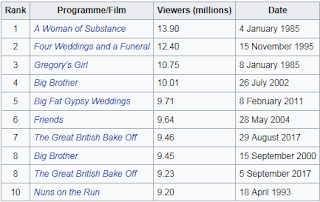Blog task: Ofcom report into news consumption 2016
1) Read this Ofcom 2016 report on the consumption of news in the UK. Note down the key statistics and changes that Ofcom document.
- Ofcom document news consumption across television, radio, print and online.
- BARB - television viewing
- NRS - national newspaper readership
- ABC - newspaper circulation
- comScore - online consumption
2) What are the most popular platforms for audiences to access news and how has this changed in recent years?
- The most popular platform for audiences to access news is television and has remained that way in recent years. Print and radio becoming less and less relevant due to the increase in technology therefor you see and increase of the internet being a way to access news as it is more versatile.
3) How do different age demographics access news in the UK?
- There is a difference in how different age demographics access news. The older generation 65+ are increasingly accessing news through the more old fashion ways like newspaper and radio and the younger generation are accessing news increasingly through the internet which is more modern which is suited to the demographic as the are the ones that are more involved with the internet.
4) What percentage of 16-24 year olds use the internet to access their news?
- 63% and increasing.
5) Does socio-economic status change attitudes to news? If so, how?
- ABC1 demographic seem to have more of an appreciation for news as they have a higher percentage for usage of news in different platforms compared to C2DE who do access news but not as much. However on both ends they seem to access news the same way through television since it is the main way people access news. people who are BAME are less likely to access news compared to white people.
6) How many different sources of news are used on average? How does differ between different groups?
- 11
7) How has news consumption through television changed in recent years?
- news consumption through television has changed between 2010 and 2016 as people who are 16+ or between the ages of 16-24 are accessing news less and less through television. However, people of the older generation 65+ are consistently accessing news through television with little change of the hours they watch in 2010 - 216hrs and 2016 - 215.
BBC One is the most popular news consumption TV channel with a high percentage of demographics accessing news through it. especially the 65+ and ABC1 being the most and on the rise. However you see that C2DE are more likely and increasingly accessing their news through ITV.
8) How much has newspaper circulation declined since 2010? Why do you think this is?
- Newspaper circulation has declined dramatically by 3/4 million since 2010. I think this is due to the increase in the fact that people are accessing their news by other means most importantly the internet. This is because with the internet you can view the news anywhere and more easily. instead of having to go out and buy it you can view the news in an instant at the comfort of your own home
9) Which are the most popular newspapers and websites in the UK? What do you know about those newspapers' political viewpoints?
- The most popular newspapers and websites are Daily Mail, Daily Mirror, The Sun, The Guardian and The Telegraph. I know that the political viewpoints for these newspapers are usually more right wing and support their readers would vote more for the conservative party.
10) How does online news consumption differ for age, gender and socio-economic status?
- Overall people who access news more are male between the ages of 16-24 and are of the ABC1 demographic. You can see in the chart that the younger generation are more inclined to using online sources as a form of accessing news that the older generation which is the same for the ABC1 andC2DE demographic. Which could relate to the fact that white people access news online more that BAME.
11) What percentage of people use social media to access news? How does this differ by age and socio-economic status?
- 20% of people use social media to access news. This differs by age as older people are less likely to be involved in social media compared to young people. People of lower socio-economic status are also less likely to use social media.
12) What percentage of users only use social media sites for their news?
- 9% in 2016
13) What are the most popular online sites for news?
- The most popular sites for news nowadays are the BBC website/app, Facebook, SKy news website/app, Google(search engine), Youtube, Daily Mail website/app, and Twitter. All above the 10% mark with facebook being 27% and BBC being 56%.
14) What percentage of 16-24 year olds access news mostly from social media?
- 40%
15) How do audiences find stories online? Do you follow links or go to the homepage of the news provider?
- Online the audience find their stories mostly directly to the website/app of the news provider. I don't follow links or go to the homepage of the news provider. I often get my news when browsing social media especially when something has gone viral for example the Paris attacks which was widely spread through social media.
New/digital media: audience and institution
16) What are the benefits for audiences from the changes new and digital media have had on the news industry?
- The benefits is that they are able to access news more efficiently and quicker as everything is becoming more immediate. Which then is being more appreciated by the audience as they are able to be updated by a click of a button or by a little notification bell on the go wherever they are.
17) What are the benefits for institutions from the changes new and digital media have had on the news industry?
- The benefits this has on the institutions is that it encourages the younger generation to get more involved in accessing news online. As the older generation are less likely to be involved in the internet. It helps them stay relevant and up to date with the new things this new generation is offering when it comes to online news.
18) What are the downsides for audiences as a result of new and digital media in news?
- For the audience the downsides of new and digital media is the fact that there has been recent problems of reliable news sources (fake news) SO it is difficult to distinguish what news is real and what news is fake.
19) What are the downsides for institutions as a result of new and digital media in news?
- The downsides for institutions as a result of new and digital media is that there are less and less people accessing news from their other news sources most specifically print news as everything is rapidly becoming more technology based.
20) Who has benefited most from the changes new and digital media have had on the news industry - audiences or institutions?
- I believe there are negatives and positives to new and digital media however in my opinion I think that audiences have benefitted more in terms of how bad the negatives of new and digital media is. It doesn't have as drastic of an effect compared to institutions. A negative for audiences is that they can encounter unreliable news sources. However, for companies they are losing money as print is becoming less and less popular due to the increase in usage of online news. from 40% in 2013 to 29% in 2016 - you see that within a couple years newspapers are not the main platform for news nowadays. Whereas the internet are on a rise from 32% in 2013 to 48% in 2016. However, television is still the main platform, the internet is rising quite quickly.
Also, another negative is that most news online is also free to access through the websites. Which still means that they would still not be making a lot of money despite the increase of accessing news online. However there are some websites that require a subscription which are doing fairly better than those which don't.









